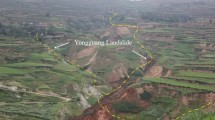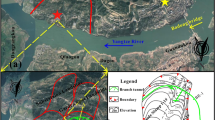Abstract
To study the formation mechanism of trailing edge fracture surfaces of retrogressive landslides, model tests, theoretical analysis, and numerical simulations are used. Firstly, a test device that could realize segmented softening of sliding zone soils was developed, and the progressive failure process was realized by injecting water into different permeable boxes. Twelve groups of model tests were carried out to observe the characteristics of the trailing edge cracks and the inclination angles of the fracture surfaces. The results showed that the longer the unstable sliding zone, the larger the deformation range of the slope. Different unstable sliding sections corresponded to a single main crack. The trailing edge cracks were mainly folded line type, (inverted) arc type, and linear type, and the folded line type cracks accounted for more than 1/2 of the total number. The inclination angles of the trailing edge fracture surfaces were mostly less than 90°, accounting for about 83.72% of the total. The inclination angles of the trailing edge fracture surfaces obtained by the sliding tensile cracking mechanism were the closest to the experimental values, and the relative errors were less than 10%. The formation mechanism of the trailing edge fracture surfaces is that tensile failure plays a leading role in the formation of the trailing edge fracture surfaces. The surface layer of the landslide body mainly undergoes tensile failure, and the middle and lower parts of the landslide body form a tensile-shear mixed action zone. The bottom sliding surface is dominated by shear failure.

























Similar content being viewed by others
Data availability
All data generated or analyzed during this study are included in this article.
References
Abdollahipour A, Rahmannejad R (2013) Investigating the effects of lateral stress to vertical stress ratios and caverns shape on the cavern stability and sidewall displacements. Arab J Geosci 6:4811–4819. https://doi.org/10.1007/s12517-012-0698-z
Alimohammadlou Y, Najafi A, Gokceoglu C (2014) Estimation of rainfall-induced landslides using ANN and fuzzy clustering methods: a case study in Saeen Slope, Azerbaijan province. Iran Catena 120:149–162. https://doi.org/10.1016/j.catena.2014.04.009
Chang CY, Bo JS, Qi WH, Qiao F, Peng D (2022) Study on instability and damage of a loess slope under strong ground motion by numerical simulation. Soil Dyn Earthq Eng 152:107050. https://doi.org/10.1016/j.soildyn.2021.107050
Ding Y, Dang C, Yuan GX, Wang QC (2012) Characteristics and remediation of a landslide complex triggered by the 2008 Wenchuan, China earthquake—Case from Yingxiu near the earthquake epicenter. Environ Earth Sci 67:161–173. https://doi.org/10.1007/s12665-011-1489-7
Eshraghian A, Martin CD, Morgenstern NR (2008) Movement triggers and mechanisms of two earth slides in the Thompson River Valley, British Columbia, Canada. Can Geotech J 45:1189–1209. https://doi.org/10.1139/T08-047
Ghorbani E, Moosavi M, Hossaini MF, Assary M, Golabchi Y (2021) Determination of initial stress state and rock mass deformation modulus at Lavarak HEPP by back analysis using ant colony optimization and multivariable regression analysis. Bull Eng Geol Env 80:429–442. https://doi.org/10.1007/s10064-020-01936-2
Graber A, Santi P, Arestegui PM (2021) Constraining the critical groundwater conditions initiation of large, irrigation-induced landslides, Siguas River Valley, Peru. Landslides 18:3753–3767. https://doi.org/10.1007/s10346-021-01767-6
Guo C, Zhang Y, Li X, Ren S, Yang Z, Wu R, Jin J (2020) Reactivation of giant Jiangdingya ancient landslide in Zhouqu County, Gansu Province, China. Landslides 17:179–190. https://doi.org/10.1007/s10346-019-01266-9
Huang D, Gu DM, Song YX, Cen DF, Zeng B (2018) Towards a complete understanding of the triggering mechanism of a large reactivated landslide in the Three Gorges Reservoir. Eng Geol 238:36–51. https://doi.org/10.1016/j.enggeo.2018.03.008
Huang D, Luo SL, Zhong Z, Gu DM, Song YX, Tomás R (2020) Analysis and modeling of the combined effects of hydrological factors on a reservoir bank slope in the Three Gorges Reservoir area. China Eng Geol 279:105858
Hu XD, Zhang L, Hu KH, Cui L, Wang L, Xia ZY (2022) Modelling the evolution of propagation and runout from a gravel-silty clay landslide to a debris flow in Shaziba, southwestern Hubei Province, China. Recent Landslides 19:2199–2212. https://doi.org/10.1007/s10346-022-01897-5
Jiang MJ, Jiang T, Crosta GB, Shi ZM, Chen H, Zhang N (2015) Modeling failure of jointed rock slope with two main joint sets using a novel DEM bond contact model. Eng Geol 193:79–96. https://doi.org/10.1016/j.enggeo.2015.04.013
Jiang Q, Cui J, Feng XT, Jiang YJ (2014) Application of computerized tomographic scanning to the study of water-induced weakening of mudstone. Bull Eng Geol Env 73:1293–1301. https://doi.org/10.1007/s10064-014-0597-5
Kaya A, Akgiin A, Karaman K, Bulut F (2016) Understanding the mechanism of slope failure on a nearby highway tunnel route by different slope stability analysis methods: a case from NE Turkey. Bull Eng Geol Env 75:945–958. https://doi.org/10.1007/s10064-015-0770-5
Kennedy R, Take WA, Siemens G (2021) Geotechnical centrifuge modelling of retrogressive sensitive clay landslides. Can Geotech J 58:1452–1465. https://doi.org/10.1139/cgj-2019-0677
Lian B, Peng J, Zhan H, Huang Q, Wang X, Hu S (2020) Formation mechanism analysis of irrigation-induced retrogressive loess landslides. Catena 195:104441. https://doi.org/10.1016/j.catena.2019.104441
Liao K, Wu Y, Miao F, Li L, Xue Y (2021) Effect of weakening of sliding zone soils in hydro-fluctuation belt on long-term reliability of reservoir landslides. Bull Eng Geol Env 80:3801–3815
Liu B, Wang CK, Liu ZY, Xu ZH, Nie LC, Pang YH, Wang N, Feng SX (2021) Cascade surface and borehole geophysical investigation for water leakage: a case study of the Dehou reservoir, China. Eng Geol 294:1–12. https://doi.org/10.1016/j.enggeo.2021.106364
Liu F, Li J (2015) Landslide erosion associated with the Wenchuan earthquake in the Minjiang River watershed: implication for landscape evolution of the Longmen Shan, eastern Tibetan Plateau. Nat Hazards 76:1911–1926. https://doi.org/10.1007/s11069-014-1575-8
Li AJ, Mburu JW, Chen CW, Yang KH (2022) Investigations of silty soil slopes under unsaturated conditions based on strength reduction finite element and limit analysis. KSCE 26(3):1095–1110. https://doi.org/10.1007/s12205-021-1162-y
Lv H, Ling C, Hu B, Ran J, Zheng Y, Xu Q, Tong J (2019) Characterizing groundwater flow in a translational rock slide of southwestern China. Bull Eng Geol Environ 78:1989–2007. https://doi.org/10.1007/s10064-017-1212-3
Oezdemir A, Delikanli M (2009) A geotechnical investigation of the retrogressive Yaka Landslide and the debris flow threatening the town of Yaka (Isparta, SW Turkey). Nat Hazards 49:113–136. https://doi.org/10.1007/s11069-008-9282-y
Pan YH, Chen JP, Wu LQ, Wang W, Tan FL (2017) Evolution mechanism and rainfall warning criteria for Maijianwo slope in Henan Province, China. Geotech Geol Eng 35:183–194
Qi X, Xu Q, Liu F (2018) Analysis of retrogressive loess flowslides in Heifangtai, China. Eng Geol 236:119–128. https://doi.org/10.1016/j.enggeo.2017.08.028
Regmi RK, Jung K, Nakagawa H, Kang J (2014) Study on mechanism of retrogressive slope failure using artificial rainfall. CATENA 122:27–41. https://doi.org/10.1016/j.catena.2014.06.001
Shan Z, Zhang W, Wang D, Wang L (2021) Numerical investigations of retrogressive failure in sensitive clays: revisiting 1994 Sainte-Monique slide, Quebec. Landslides 18:1327–1336. https://doi.org/10.1007/s10346-020-01567-4
Skempton AW (1964) Long-term stability of clay slopes. Geotechnique 14(2):77–102
Su X, Wei WH, Ye WL, Meng XM, Wu WJ (2019) Predicting landslide sliding distance based on energy dissipation and mass point kinematics. Nat Hazards 96:1367–1385. https://doi.org/10.1007/s11069-019-03618-z
Sun LJ, Li CJ, Shen FM (2022) Two-surface progressive failure mechanism and stability quantitative evaluation of water-induced weakening retrogressive landslides: case study for clay landslides. China Bull Eng Geol Env 81:382. https://doi.org/10.1007/s10064-022-02860-3
Sun LJ, Li CJ, Shen FM, Zhang HZ (2023) Reactivation mechanism and evolution characteristics of water softening-induced reservoir-reactivated landslides: a case study for the Three Gorges Reservoir Area, China. Bull Eng Geol Env 82:66. https://doi.org/10.1007/s10064-023-03084-9
Sun L, Yang T, Cheng Q, Wu D (2018) Experimental study on couse of progressive formation of retrogressive landslide. J Southwest Jiaotong Univ 53:762–771 (in Chinese)
Take WA, Beddoe RA, Davoodi-Bilesavar R, Phillips R (2015) Effect of antecedent groundwater conditions on the triggering of static liquefaction landslides. Landslides 12:469–479. https://doi.org/10.1007/s10346-014-0496-7
Troncone A, Conte E, Donato A (2015) Two and three-dimensional numerical analysis of the progressive failure that occurred in an excavation-induced landslide. Eng Geol 183:265–275. https://doi.org/10.1016/j.enggeo.2014.08.027
Wang B, Vardon PJ, Hicks MA (2016) Investigation of retrogressive and progressive slope failure mechanisms using the material point method. Comput Geotech 78:88–98. https://doi.org/10.1016/j.compgeo.2016.04.016
Wang Q, Wang Z, Su Y, Zhong X, Wang L, Ma H, Zhang G, Woolery EE, Liu K (2020) Characteristics and mechanism of the landslide in Yongguang village, Minxian County, China. Nat Hazards 105:1413–1438. https://doi.org/10.1007/s11069-020-04360-7
Wei JB, Zhao Z, Xu C, Wen Q (2019) Numberical investigation of landslide kinetics for the recent Mabian landslide (Sichuan, China). Landslides 16:2287–2298. https://doi.org/10.1007/s10346-019-01237-0
Wu ZJ, Zhang D, Wang SN, Liang C, Zhao DY (2020) Dynamic-response characteristics and deformation evolution of loess slopes under seismic loads. Eng Geol 267:105507. https://doi.org/10.1016/j.enggeo.2020.105507
Xu L, Dai FC, Chen J, Iqbal J, Qu YX (2014) Analysis of a progressive slope failure in the Xiangjiaba reservoir area, Southwest China. Landslides 11:55–66. https://doi.org/10.1007/s10346-012-0373-1
Xu R, Liu EL, Jiang XQ, Tian JQ, Sun Y (2020) Analysis on evolution of mesostructure of cohesionless soil ground upon loading. Powder Technol 368:1–13. https://doi.org/10.1016/j.powtec.2020.04.048
Xu X, Guo WZ, Liu Y, Ma J, Wang W, ZhangH GH (2017) Landslides on the loess plateau of China: a latest statistics together with a close look. Nat Hazards 86:1393–1403. https://doi.org/10.1007/s11069-016-2738-6
Yang T, Sun LJ, Cheng QH, Zhong W (2018) Experimental study on formation mechanism of the trailing edge failure surface of retrogressive landslide. CJRME 37(Supp2):3842–3849
Yin YP, Huang BL, Zhang Q, Yan GQ, Dai ZW (2020) Research on recently occurred reservoir-induced Kamenziwan rockslide in Three Gorges Reservoir, China. Landslides 17:1935–1949. https://doi.org/10.1007/s10346-020-01394-7
Zhang KQ, Wang LQ, Zhang WG, Zhang ZH, Zhou H (2021) Formation and failure mechanism of the Xinfangzi landslide in Chongqing city (China). Appl Sci 11:8963. https://doi.org/10.3390/app11198963
Zhang LF, Wu YP, Miao FS, Li LW, Kang T (2020) Mechanical model and stability analysis of progressive failure for thrust-type gently inclined shallow landslide. Rock Soil Mech 40(12):4767–4776. https://doi.org/10.16285/j.rsm.2018.1885
Zhang S, Xu Q, Hu ZM (2016) Effects of rainwater softening on red mudstone of deep-seated landslide, Southwest China. Eng Geol 204:1–13. https://doi.org/10.1016/j.enggeo.2016.01.013
Zuo S, Zhao LH, Deng DP, Han Z, Zhao B, Zhao ZG (2021) Back analysis of shear strength parameters for progressive landslides: case study of the Caifengyan landslide. China Bull Eng Geol Env 81(1):19. https://doi.org/10.1007/s10064-021-02507-9
Acknowledgements
The authors thank Prof. Yang Tao (Southwest Jiaotong University) for his guidance on the model test and theoretical analysis. This research was supported by the Science and Technology Projects of Education Department of Jilin Province (Grant No. JJKH20210261KJ).
Author information
Authors and Affiliations
Corresponding author
Ethics declarations
Conflict of interest
The authors declare no competing interests.
Rights and permissions
Springer Nature or its licensor (e.g. a society or other partner) holds exclusive rights to this article under a publishing agreement with the author(s) or other rightsholder(s); author self-archiving of the accepted manuscript version of this article is solely governed by the terms of such publishing agreement and applicable law.
About this article
Cite this article
Sun, L., Shen, F. & Li, C. Water-induced weakening retrogressive landslides: a study on the progressive failure process and formation mechanism of trailing edge fracture surfaces. Bull Eng Geol Environ 82, 201 (2023). https://doi.org/10.1007/s10064-023-03210-7
Received:
Accepted:
Published:
DOI: https://doi.org/10.1007/s10064-023-03210-7




